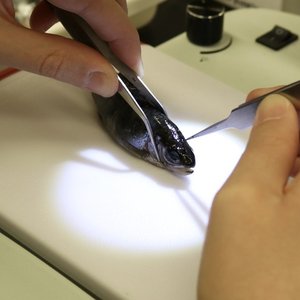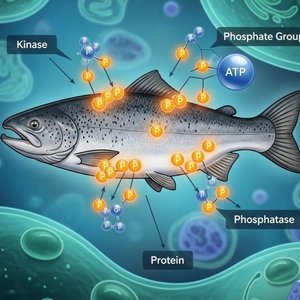Abstract
The manual describes the major production techniques currently employed for the cultivation of the major types of live food commonly used in larviculture, as well as their application potential in terms of their nutritional and physical properties and feeding methods.
The manual is divided into different sections according to the major groups of live food organisms used in aquaculture, namely micro-algae, rotifers, Artemia, natural zooplankton, and copepods, nematodes and trochophores.
Keywords
Live food organisms, micro-algae, rotifers, Artemia, natural zooplankton, copepods, nematodes, trochophores.
Table of contents
1. INTRODUCTION
2. MICRO-ALGAE
2.1. Introduction
2.2. Major classes and genera of cultured algal species
2.3. Algal production
2.3.1. Physical and chemical conditions
2.3.1.1. Culture medium/nutrients
2.3.1.2. Light
2.3.1.3. pH
2.3.1.4. Aeration/mixing
2.3.1.5. Temperature
2.3.1.6. Salinity
2.3.2. Growth dynamics
2.3.3. Isolating/obtaining and maintaining of cultures
2.3.4. Sources of contamination and water treatment
2.3.5. Algal culture techniques
2.3.5.1. Batch culture
2.3.5.2. Continuous culture
2.3.5.3. Semi-continuous culture
2.3.6. Algal production in outdoor ponds
2.3.7. Culture of sessile micro-algae
2.3.8. Quantifying algal biomass
2.3.9. Harvesting and preserving micro-algae
2.3.10. Algal production cost
2.4. Nutritional value of micro-algae
2.5. Use of micro-algae in aquaculture
2.5.1. Bivalve molluscs
2.5.2. Penaeid shrimp
2.5.3. Marine fish
2.6. Replacement diets for live algae
2.6.1. Preserved algae
2.6.2. Micro-encapsulated diets
2.6.3. Yeast-based diets
2.7. Literature of interest
2.8. Worksheets
Worksheet 2.1.: Isolation of pure algal strains by the agar plating technique
Worksheet 2.2.: Determination of cell concentrations using haematocytometer according to Fuchs-Rosenthal and Burker.
Worksheet 2.3.: Cellular dry weight estimation of micro-algae.
3. ROTIFERS
3.1. Introduction
3.2. Morphology
3.3. Biology and life history
3.4. Strain differences
3.5. General culture conditions
3.5.1. Marine rotifers
3.5.1.1. Salinity
3.5.1.2. Temperature
3.5.1.3. Dissolved oxygen
3.5.1.4. pH
3.5.1.5. Ammonia (NH3)
3.5.1.6. Bacteria
3.5.1.7. Ciliates
3.5.2. Freshwater rotifers
3.5.3. Culture procedures
3.5.3.1. Stock culture of rotifers
3.5.3.2. Upscaling of stock cultures to starter cultures
3.5.3.3. Mass production on algae
3.5.3.4. Mass production on algae and yeast
3.5.3.5. Mass culture on yeast
3.5.3.6. Mass culture on formulated diets
3.5.3.7. High density rearing
3.5.4. Harvesting/concentration of rotifers
3.6. Nutritional value of cultured rotifers
3.6.1. Techniques for (n-3) HUFA enrichment
3.6.1.1. Algae
3.6.1.2. Formulated feeds
3.6.1.3. Oil emulsions
3.6.2. Techniques for vitamin C enrichment
3.6.3. Techniques for protein enrichment
3.6.4. Harvesting/concentration and cold storage of rotifers
3.7. Production and use of resting eggs
3.8. Literature of interest
3.9 Worksheets
Worksheet 3.1. Preparation of an indicator solution for determination of residual chlorine
4. ARTEMIA
4.1. Introduction, biology and ecology of Artemia
4.1.1. Introduction
4.1.2. Biology and ecology of Artemia
4.1.2.1. Morphology and life cycle
4.1.2.2. Ecology and natural distribution
4.1.2.3. Taxonomy
4.1.2.4. Strain-specific characteristics
4.1.3. Literature of interest
4.2. Use of cysts
4.2.1. Cyst biology
4.2.1.1. Cyst morphology
4.2.1.2. Physiology of the hatching process
4.2.1.3. Effect of environmental conditions on cyst metabolism
4.2.1.4. Diapause
4.2.2. Disinfection procedures
4.2.3 Decapsulation
4.2.4. Direct use of decapsulated cysts
4.2.5. Hatching
4.2.5.1. Hatching conditions and equipment
4.2.5.2. Hatching quality and evaluation
4.2.6. Literature of interest
4.2.7. Worksheets
Worksheet 4.2.1.: Procedure for estimating water content of Artemia cysts
Worksheet 4.2.2.: Specific diapause termination techniques
Worksheet 4.2.3.: Disinfection of Artemia cysts with liquid bleach
Worksheet 4.2.4.: Procedures for the decapsulation of Artemia cysts
Worksheet 4.2.5.: Titrimetric method for the determination of active chlorine in hypochlorite solutions
Worksheet 4.2.6.: Artemia hatching
Worksheet 4.2.7.: Determination of hatching percentage, hatching efficiency and hatching rate
4.3. Use of nauplii and meta-nauplii
4.3.1. Harvesting and distribution
4.3.2. Cold storage
4.3.3. Nutritional quality
4.3.4. Enrichment with nutrients
4.3.5. Enrichment for disease control
4.3.6. Applications of Artemia for feeding different species
4.3.6.1. Penaeid shrimp
4.3.6.2. Freshwater prawn
4.3.6.3. Marine fish
4.3.6.4. Freshwater fish
4.3.6.5. Aquarium fish
4.3.7. Literature of interest
4.3.8. Worksheets
Worksheet 4.3.1.: Standard enrichment for Great Salt Lake Artemia.
4.4. Tank production and use of ongrown Artemia
4.4.1. Nutritional properties of ongrown Artemia
4.4.2. Tank production
4.4.2.1. Advantages of tank production and tank produced biomass
4.4.2.2. Physico-chemical conditions
4.4.2.3. Artemia
4.4.2.4. Feeding
4.4.2.5. Infrastructure
4.4.2.6. Culture techniques
4.4.2.7. Enrichment of ongrown Artemia
4.4.2.8. Control of infections
4.4.2.9. Harvesting and processing techniques
4.4.2.10. Production figures and production costs
4.4.3. Literature of interest
4.4.4. Worksheets
Worksheet 4.4.1: Feeding strategy for intensive Artemia culture.
4.5. Pond production
4.5.1. Description of the different Artemia habitats
4.5.1.1. Natural lakes
4.5.1.2. Permanent solar salt operations
4.5.1.3. Seasonal units
4.5.2. Site selection
4.5.2.1. Climatology
4.5.2.2. Topography
4.5.2.3. Soil conditions
4.5.3. Pond adaptation
4.5.3.1. Large permanent salt operations
4.5.3.2. Small pond systems
4.5.4. Pond preparation
4.5.4.1. Liming
4.5.4.2. Predator control
4.5.4.3. Fertilization
4.5.5. Artemia inoculation
4.5.5.1. Artemia strain selection
4.5.5.2. Inoculation procedures
4.5.6. Monitoring and managing the culture system
4.5.6.1. Monitoring the Artemia population
4.5.6.2. Abiotic parameters influencing Artemia populations
4.5.6.3. Biotic factors influencing Artemia populations
4.5.7. Harvesting and processing techniques
4.5.7.1. Artemia biomass harvesting and processing
4.5.7.2. Artemia cyst harvesting and processing
4.5.8. Literature of interest
4.5.9. Worksheets
Worksheet 4.5.1.: Pond improvements and harvesting procedures
Worksheet 4.5.2.: Procedures for the brine processing step
Worksheet 4.5.3.: Procedures for the freshwater processing step
5. ZOOPLANKTON
5.1. Wild zooplankton
5.1.1. Introduction
5.1.2. Collection from the wild
5.1.3. Collection techniques
5.1.3.1. Plankton nets
5.1.3.2. Trawl nets
5.1.3.3. Baleen harvesting system
5.1.3.4. Flow-through harvesting
5.1.3.5. Plankton light trapping
5.1.4. Zooplankton grading
5.1.5. Transport and storage of collected zooplankton
5.2. Production of copepods
5.2.1. Introduction
5.2.2. Life cycle
5.2.3. Biometrics
5.2.4. Nutritional quality
5.2.5. Culture techniques
5.2.5.1. Calanoids
5.2.5.2. Harpacticoids
5.2.6. Use of resting eggs
5.2.7. Applications in larviculture
5.3. Mesocosm systems
5.3.1. Introduction
5.3.2. Types of mesocosms
5.3.2.1. Pold system (2-60 m³)
5.3.2.2. Bag system (50-200 m³)
5.3.2.3. Pond system
5.3.2.4. Tank system
5.3.3. Mesocosm protocol
5.3.4. Comparison to intensive methods
5.4. Literature of interest
6. CLADOCERANS, NEMATODES AND TROCHOPHORA LARVAE
6.1. Daphnia and Moina
6.1.1. Biology and life cycle of Daphnia
6.1.2. Nutritional value of Daphnia
6.1.3. Feeding and nutrition of Daphnia
6.1.4. Mass culture of Daphnia
6.1.4.1. General procedure for tank culture
6.1.4.2. Detrital system
6.1.4.3. Autotrophic system
6.1.4.4. General procedure for pond culture
6.1.4.5. Contamination
6.1.5. Production and use of resting eggs
6.1.6. Use of Moina
6.2. Nematodes
6.3. Trochophora larvae
6.3.1. Introduction
6.3.2. Production of trochophora larvae
6.3.2.1. Mussel larvae
6.3.2.2. Pacific oyster and Manila clam larvae
6.3.3. Quality control of the produced trochophora larvae
6.3.4. Cryopreservation
6.4. Literature of interest
Author(s)
Edited by Patrick Lavens and Patrick Sorgeloos
Laboratory of Aquaculture & Artemia Reference Center, University of Gent, Belgium
Publication
FAO Fisheries Technical Paper. No. 361. Rome, FAO. 1996. 295p
Link
Read this manual on the FAO website l Download as PDF from link below:
manual-on-the-production-and-use-of-live-food-for-aquaculture







